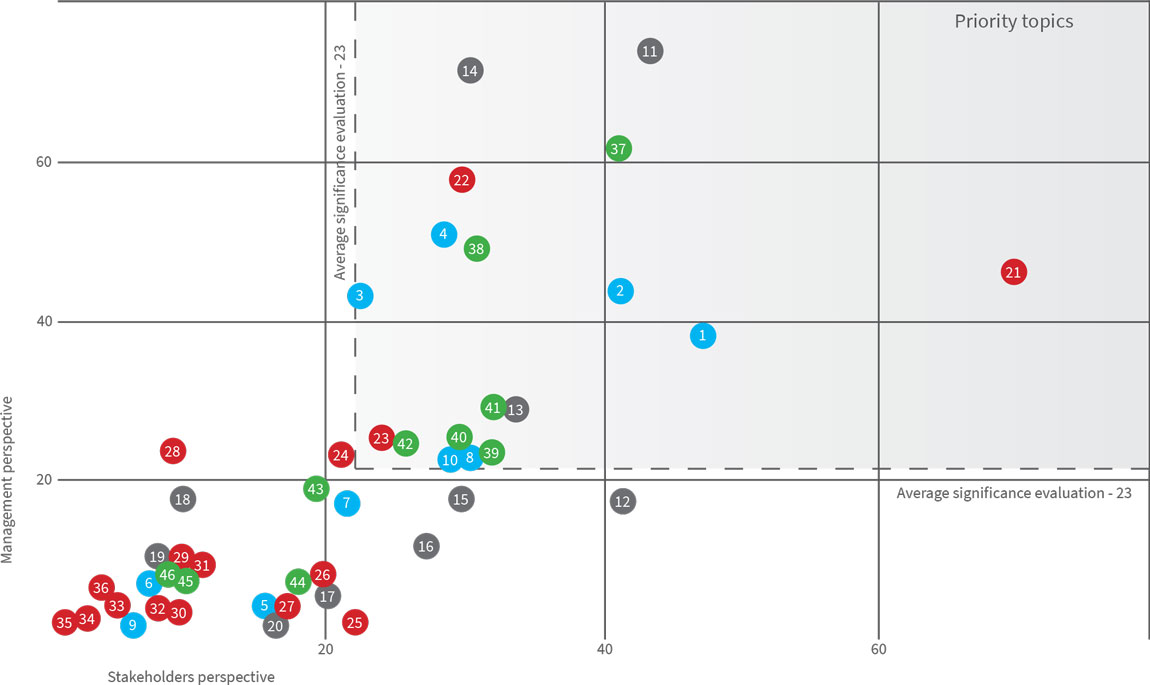Navigation Map
- strategy (insurance, health, investments, finances);
- sustainable development (sales, employees, social responsibility, natural environment and ethics).
PRACTICES
In the Chapter
GRIs
In the Chapter
GRIs
In the Chapter
List of GRIs
In the Chapter
GRIs
In the Chapter
GRIs
In the Chapter
GRIs
In the Chapter
GRIs
In the Chapter
GRIs
In the Chapter
GRIs
In the Chapter
GRIs
In the Chapter
Operating model
GRIs
- About the report
- Results
- Comment on the financial results for 2020
- Major factors contributing to the consolidated financial result
- PZU Group’s income
- PZU Group’s claims paid and technical provisions
- PZU Group’s acquisition and administrative expenses
- Drivers and atypical events affecting the results
- PZU Group’s asset and liability structure
- Contribution made by the market segments to the consolidated result
- Issuer’s financial results – PZU (PAS)
- Impact of the COVID-19 pandemic on the PZU Group’s results
- Business strategy (2017-2020)
- CSR strategy(2017-2020)
- Supplementary information and notes
- 1. Introduction
- 2. Composition of PZU Group
- 3. Shareholder structure
- 4. Composition of the Management Board, Supervisory Board and PZU Group Directors
- 5. Key accounting policies, key estimates and judgments
- 5.1 Impact of the COVID-19 pandemic on the estimates and assumptions
- 5.2 Changes in accounting policies and estimates, errors from previous years
- 5.3 Amendments to the applied IFRS
- 5.4 Explanation of differences between the 2019 annual consolidated financial statements and these consolidated financial statements
- 5.5 Consolidation principles
- 5.6 Measurement of transactions and balances denominated in foreign currencies and FX rates used
- 5.7 Purchase method
- 5.8 Classification of insurance contracts in accordance with IFRS 4
- 6. Segment reporting
- 7. Risk management
- 8. Equity management
- 9. Fair value
- 10. Gross written premium
- 11. Fee and commission income
- 12. Interest income calculated using the effective interest rate
- 13. Other net investment income
- 14. Result on derecognition of financial instruments and investments
- 15. Movement in allowances for expected credit losses and impairment losses on financial instruments
- 16. Net movement in fair value of assets and liabilities measured at fair value
- 17. Other operating income
- 18. Claims and movement in technical provisions
- 19. Fee and commission expense
- 20. Interest expenses
- 21. Acquisition costs
- 22. Administrative expenses
- 23. Employee expenses
- 24. Other operating expenses
- 25. Income tax
- 26. Earnings per share
- 27. Goodwill
- 28. Intangible assets
- 29. Other assets
- 30. Deferred acquisition cost
- 31. Property, plant and equipment
- 32. Investment property
- 33. Entities carried by the equity method
- 34. Loan receivables from clients
- 35. Financial derivatives
- 36. Investment financial assets
- 37. Receivables
- 38. Impairment of financial assets
- 39.Cash and cash equivalents
- 40. Equity attributable to equity holders of the parent
- 41. Technical provisions
- 42. Subordinated liabilities
- 43. Liabilities on the issue of own debt securities
- 44. Liabilities to banks
- 45. Liabilities to clients under deposits
- 46. Other liabilities
- 47. Provisions
- 48. Deferred income tax
- 49. Assets and liabilities held for sale
- 50. Lease
- 51. Assets securing receivables, liabilities and contingent liabilities
- 52. Contingent assets and liabilities
- 53. Offsetting financial assets and financial liabilities
- 54. Notes to the consolidated cash flow statement
- 55. Disputes
- 56. Transactions with related entities
- 57. Headcount
- 58. Other information
- Financial data (2019-2020)
- Financial data (2016-2020) Focus on: Results - check the highlights of the year!
- Comment on the financial results for 2020
- Market and business
- External environment
- Business model
- Structure of the Group
- Operating model
- Brand management
- Insurance
- Non-life insurance (PZU, LINK4 and TUW PZUW)
- Life insurance (PZU Życie)
- Insurance (international operations)
- Investments
- Investments (PZU TFI)
- Investments (PTE PZU)
- Health
- Health (health companies)
- Banking and strategic partnerships
- Banking (Bank Pekao, Alior Bank)
- Other operating areas
Focus on: Market and business - check the highlights of the year!
- Capitals (IIRC)
- Strategy and outlook 2021+
- Risk and ethics
- Objective of risk management
- Risk management system
- Risk appetite
- Risk management process
- PZU Group's risk profile
- ESG risks
- Risk vulnerability
- Reinsurance operations
- Capital management
- Ethical foundations of doing business
- Preventing corruption and conflicts of interest
- Whistleblowing System
- Transaction security
- Tax transparency
- Cooperation with suppliers Focus on: Risk and ethics - check the highlights of the year!
- Corporate governance
- Application of corporate governance rules
- System of control in the process of preparing financial statements
- Audit firm auditing the financial statements
- PZU's share capital and its shareholders
- Rules for amending the Company's Articles of Association
- Shareholder Meeting and shareholder rights
- Supervisory Board and Management Board
- Compensation paid to members of supervisory and management bodies
- Diversity policy Focus on: Corporate governance - check the highlights of the year!
- Shares and bonds
- Equity and bond market
- PZU's share price
- Banking sector on the Warsaw Stock Exchange
- PZU's investor relations
- Analysts' recommendations regarding PZU's shares
- PZU Group's Capital and Dividend Policy
- Debt financing of PZU, Bank Pekao and Alior Bank
- Rating
- Calendar of PZU's major corporate events in 2021 Focus on: Shares and bonds - check the highlights of the year!
Materiality matrix

[GRI 102-50]
The PZU Group’s integrated report contains data for 2020. It is in line with the overall strategy to build understanding for, and improvement in, the ESG results and build relations with key stakeholders.
This report has been prepared in accordance with the amended Accounting Act of 29 September 1994 and its requirements pertaining to non-financial reporting. Valuable hints on preparing the substantive content of this report were also provided by global guidelines and standards, among others, the international reporting standard of the Global Reporting Initiative (GRI Standards), international integrated reporting guidelines (International Integrated Reporting Council, IIRC), and guidelines of the European Commission on non-financial reporting with emphasis on reporting climate-related data and recommendations of the Task Force on Climate-related Financial Disclosures (TCFD).
 “The information presented herein has been prepared with the utmost diligence according to the principles of transparency and openness espoused by the entire PZU Group. The data is accurate, consistent, comprehensive and concise at the same time. Thanks to this approach the non-financial report helps companies improve in how they practice corporate social responsibility. The issues discussed and the metrics concerning the achievement of goals show the specific actions which the PZU Group takes to achieve sustainable development”.
“The information presented herein has been prepared with the utmost diligence according to the principles of transparency and openness espoused by the entire PZU Group. The data is accurate, consistent, comprehensive and concise at the same time. Thanks to this approach the non-financial report helps companies improve in how they practice corporate social responsibility. The issues discussed and the metrics concerning the achievement of goals show the specific actions which the PZU Group takes to achieve sustainable development”. [GRI 102-45]
In accordance with the requirements of the Accounting Act, the report on the PZU Group’s non-financial information in 2020 encompasses non-financial information and consolidated data pertaining to the PZU Group and PZU, its parent company in line with the structure of the organization included in the Consolidated Financial Statements for the year ended 31 December 2020.
The data from PZU Życie, the Alior Bank Group, the Pekao Group, LINK4, TUW PZUW and the foreign entities doing business as AAS Balta, AB Lietuvos Draudimas and PrJSC IC PZU Ukraine are consolidated and presented in the information pertaining to the PZU Group. In turn, Alior Bank and Bank Pekao as public interest entities have also elected to make separate disclosures concerning their non-financial data, also in consolidated form.
The PZU Zdrowie Group in which PZU Zdrowie is the parent company, Armatura Kraków and PZU CO (CIG) are not public interest entities and are not subject to separate regulatory obligations regarding disclosure of non-financial data. Information regarding these companies and the other PZU Group companies has been presented in the consolidated data showcased in the report.
Additionally, updated consolidated non-financial data for 2019 for the aforementioned entities have been presented.
[GRI 102-46] [IIRC]
In line with the approach stemming from the principle of materiality, the various pieces of non-financial information have been presented to the extent necessary to evaluate the development, performance and standing of the PZU Group. Relatively less space has been devoted to smaller entities whose impact on the overall depiction of the PZU Group is minor or simply marginal.
When defining the substantive part of the report, in accordance with the international guidelines, a process comprising the following stages has been followed:
- Identification – After analyzing the internal documents and external publications pertaining to the Group and press information of companies, and a review of industry reports, 46 key issues in corporate responsibility and business were selected;
- Prioritization – In January 2021 the Group’s stakeholders: retail investors, suppliers, clients, business partners, brokerage house analysts, representatives of nongovernmental organizations and public institutions, representatives of central administration and Group employees ranging from senior management to lower echelons – in total more than 100 people took part in the survey concerning the materiality of the issues included in the report on non-financial information. This questionnaire also made it possible to identify the PZU Group’s well-known corporate social responsibility activities that are highly regarded by stakeholders. The findings of the questionnaire made it possible to determine what makes the PZU Group stand out as an entity operating in line with sustainable development and corporate social responsibility. This questionnaire also made it possible to identify the PZU Group’s well-known corporate social responsibility activities that are highly regarded by stakeholders. It also made it possible to determine what makes the PZU Group stand out as an entity operating in line with sustainable development and corporate social responsibility;
- Validation – PZU Group representatives confirmed the final list of priority issues taken into account in the 2020 report.
[GRI 102-47, GRI 103-1]
Topics identified as being significant
The findings of the questionnaire have been presented on the significance matrix below. The Y axis presents the significance of topics from the governance perspective identified by the representatives of senior management. The X axis presents the topics selected by the Group’s other stakeholders. Based on the results of the analysis of the questionnaire, the identification of key issues and their prioritization, 18 significant topics from 4 areas were defined.

I. Employee and human rights issues
1 Transparent job and career path assessment system;
2 Education and development of employees at various levels - offering development opportunities, training, education co-funding;
3 Satisfaction survey and dialogue with employees and internal communication and its various forms;
4 Caring for occupational safety and health, including the provision of ergonomic conditions during remote work;
8 Promoting health and a healthy lifestyle among employees, ensuring work-life balance, well-being initiatives;
10 Structure of employment.
II. Social commitment
11 Commitment to fighting the Covid-19 pandemic;
13 Employee engagement in socially beneficial activities, employee volunteerism;
14 Prevention activities in safety and cooperation with rescue services.
III. Responsible management
21 Plans and strategy for the future;
22 Research and development activity, implementing innovative solutions;
23 Cybersecurity.
IV. Environment
37 Company’s response to the challenges related to climate change and reducing the adverse environmental impact;
38 Green office: initiatives, effects, internal ecological culture of employees;
39 Education and engagement of clients, employees and other stakeholders in environmental protection;
40 Impact exerted by natural catastrophes on the company’s business and its product offering;
41 Limitation of the negative environmental impact, including the reduction of its carbon footprint;
42 Incorporating environmental aspects when designing new products.
Investor Relations Team
e-mail: IR@pzu.pl
Magdalena Komaracka, IR Director, tel. +48 (22) 582 22 93
Piotr Wiśniewski, IR Manager, tel. +48 (22) 582 26 23
Aleksandra Jakima-Moskwa, tel. +48 (22) 582 26 17
Aleksandra Dachowska, tel. +48 (22) 582 43 92
Piotr Wąsiewicz, tel. +48 (22) 582 41 95
